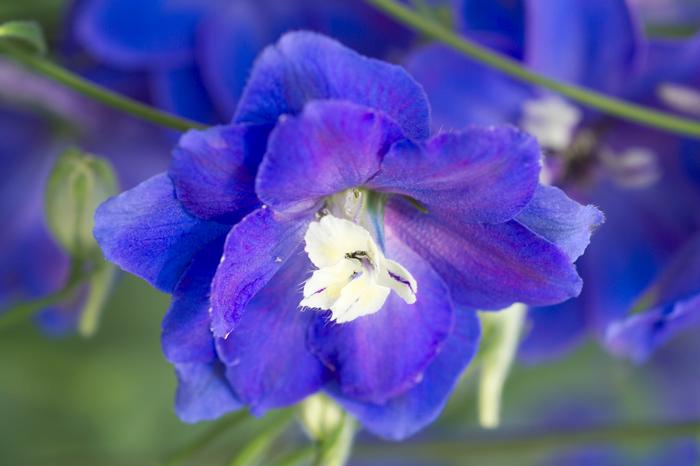History
Delphinium, a native throughout the Northern Hemisphere includes about 300 species in the Ranunculaceae (Buttercup) Family. The name “delphinium” originated with the ancient Greeks who thought the shape of the new flower bud with spur resembled that of a dolphin’s nose. Delphinium is often called by the common name “larkspur” which is shared between the perennial Delphinium and the annual Consolida species.
Most delphinium hybrids and cultivars are derived from Delphinium elatum. Hybridisation was developed in the 19th-century led by Victor Lemoine in France. Other hybrid crosses have included D. bruninianum, D. cardinale, D. cheilanthum, and D. formosum,
The Pacific Giant hybrids are a popular variety today that typically grows four to six feet tall on long stems developed by Frank Reinelt, renowned breeder in the United States. Millennium delphinium hybrids, bred by Dowdeswell’s Delphinium Ltd. in New Zealand, are reportedly better in warmer, more humid climates than the Pacific hybrids. Flower colors in shades of red, orange, and pink can be found hybridized from D. cardinale by Reinelt and Samuelson.
Delphinium cultivars in production today
The most common delphiniums in commercial production are Delphinium elatum and Pacific hybrid varieties known for their long spiky stems and beautiful two-foot long flower stems. These mainly seed propagated plants are available through garden retailers. A few very interesting hybrids are available from tissue culture with rare and unusual flower colors. Also, with new breeding, “bush” type delphiniums are coming to the market from crosses between Delphinium Beladonna, Bellamosum, Grandilflorum and Cardinale hybrids.
In the Delphinium elatum hybrids, the best known varieties are the New Zealand Hybrids with strong colors and medium sized plants. Some older and newer varieties are available from both seed and plants: Pagans Purple, Royal Aspiration, New Millennium Stars, Blushing Brides, Dasante Blue, Candle, Colbalt Dreams and many more.
Delphinium Pacific Hybrid varieties are slightly taller than New Millennium varieties, but very similar in growing habit and colors. Pacific Hybrids are also referred as Pacific Giant hybrids. The most popular varieties are Black Knight, Galahad, Blue Jay, Blue Bird, and King Arthur.
The Delphinium Guardian, Aurora and Magic Fountain series also offer great colors and very controlled growth; this new breeding is beginning to replace some of the older elatum hybrids on the market. Blue purple and lavender are the most popular colors in this series.
There are three interesting and unusual Delphiniums originating from Tissue Culture coming from Holland offering very distinctive and spectacular looks with some exciting color breakthroughs: Red Caroline, Princess Caroline and Delft Blue.
New grandiflorum, cardinale, and nudicaule hybrids offer a bouquet of flowers instead of one large flower. Varieties of these include Diamonds Blue, Summer Nights, Summer Stars, Summer Morning, and Summer Clouds.
Delphiniums in the garden
Homeowners can begin their Delphiniums from seed or as a plant through your garden retailer. Delphiniums are very easy to grow in the northern climates with very little maintenance. As a perennial, they tolerate cool northern climates and overwinter with ease as a hardy perennial in Zone 4. Some misunderstanding about non-hardiness actually comes from hot and humid climates, which the plants cannot tolerate for long periods of time. Delphiniums act more like annuals in the southern climates. After the first flush of flowers, plants can be cut back and a second set of flowers will appear on shorter stems. Mulching is not recommended, because it can cause stem rot. After heavy frost, late-fall early-winter plants need to be cut back and cleaned up. Winter protection is not necessary, but plants can be covered with hay or leaves to protect the crowns. This protection needs to be removed very early in spring to maintain a healthy Delphinium in the garden. In natural snow-covered areas, no extra protection is needed.
Successful Seed Germination
A few guidelines for successful germination when starting from seeds:
- Seeding timeframe is very important. September to March is the best time to seed delphiniums.
- Seeds must be fresh. Delphinium seeds lose viability after one year, and germination can be poor.
- Presoaking seeds will improve the germination rate by 20-30%.
- Seed germination temperature should be 65F night and 75F day.
- Seeds must be covered with only 1/8” of soil and soil media should be evenly moist, but not too wet, during germination. The most common cause of loss is rotting due to keeping the germination media too wet. Tray size selection is also important. Smaller rather than larger is the best.
- After plants have two true sets of leaves, they can be transplanted into a well-prepared garden bed naturally protected from high winds.
Pests and Disease
Delphiniums are generally very easy to grow plants, but a few issues can be encountered during growing and propagation.
Powdery Mildew : High humidity and poor air circulation can cause powdery mildew. The best way to get rid of this problem is by keeping the foliage as dry as possible.
Snails and Slugs: To alleviate this problem, try setting up some simple beer traps.
Source: National Garden Bureau, ngb.org

